The Dragon Quest franchise has had a mission over the course of its years: be the classic RPG experience.
The first entries of the franchise, back in the late 80’s, cemented the RPG genre in video games and paved the way for later japanese successes such as Final Fantasy, Breath of Fire, and Mother. It’s fair to say that the original Dragon Quest and its two sequels found the perfect formula for the genre, creating a digital experience of Dungeons & Dragons unlike any other game at the time.
Dragon Quest, however, stopped evolving. After its initial push, the franchise hit a wall, on purpose or not. While the RPG genre started to evolve towards the 16-bit era and beyond, adopting quality-of-life improvements, achieving faster-paced combat, creating visual experiences with better feedback, or even finding new music themes for new experiences, the Dragon Quest franchise stood its ground and denied change. The core of the first three games remained throughout the years: the same combat system, the same music themes, the same art design, the same story surrounding a destined hero fighting darkness. It offered insights of new mechanics in every new release, but none of those were impactful enough to change the experience established in the first three games.
Its unwavering stand had its cost though. Unlike Final Fantasy and Chrono Trigger, the Dragon Quest games failed to breach the western market and slowly became restricted to the japanese audience and a few old-school fans of the Famicom age. When the Playstation was released with all its technological improvements and the RPG genre boomed with incredible variety and new ideas, Dragon Quest seemed to be relegated to a relic of old times. However, instead of accepting such fate and fading away, the franchise took that mantle of nostalgia and moved on, releasing its next games with the minimal amount of changes possible.
The result was very positive for the most part. While still lackluster in the western market, Dragon Quest continued its reign in Japan as a popular-hit franchise. Not even the full transition to 3D graphics, with Dragon Quest VIII, was enough to change the heart of the games: the art style was still the same, the music themes were still the same, and combat had only slightly changed its dynamic to show our heroes as they fought wacky slimes and big-eyed demons. The first real change for the franchise only came in its tenth entry, when it pushed towards online play and had to do away with turn-based combat, although it still retained every other core element untouched.
Why am I talking about the franchise though? Isn’t this supposed to be a review of Dragon Quest XI S: Echoes of an Elusive Age? Well, yes. What happens, however, is that, after long years, it can be said that Dragon Quest XI is, finally, the first game of the franchise to evolve at many aspects and at the same time. It is also a clear homage to every previous entries.
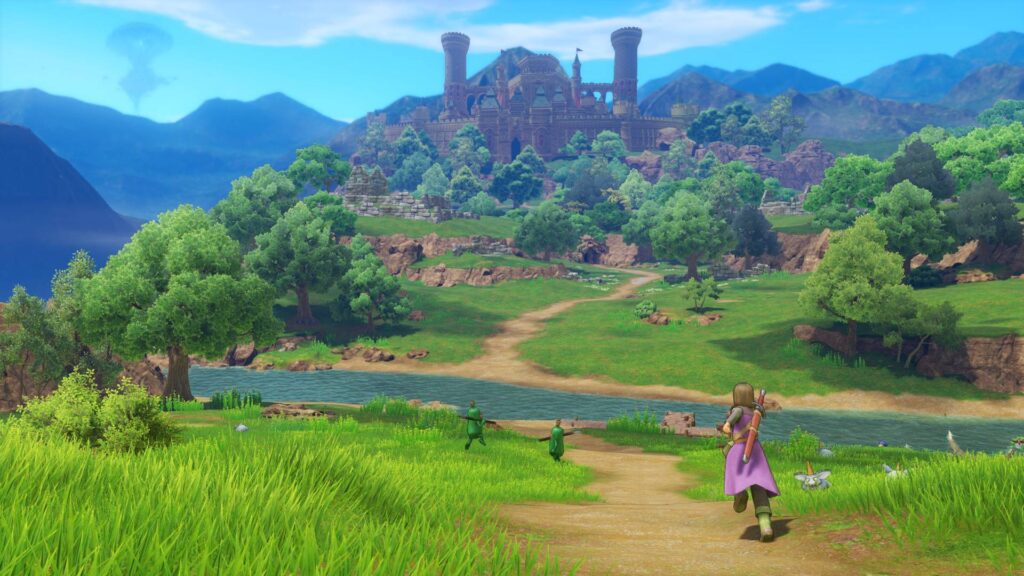
The first proper modern Dragon Quest
Although still true to its mission, Dragon Quest XI lands on modern consoles with a massive production leap. Its art style is still the same, borrowing from Akira Toriyama’s talents, but the visual quality of the game is simply superb. The colorful characters and areas of the World of Erdrea are brimming with details, high quality assets, superb special effects, and capable facial expressions. This improvement brings a much needed help to Dragon Quest’s dynamics and storytelling, enhancing the drama and action of it in ways that no previous entry was capable of. There are still the goofy enemies with big eyes and every character has a clone in Dragon Ball, but the new artistic choices make it possible to bring a serious tone to some characters and events that wasn’t possible with Akira Toriyama’s character design alone.
The new dynamic brought by the high-quality visuals also helps to give combat a much-needed improvement. It retains the faithful turn-based structure, but the new production value now forces the game to be faster, reducing textual information on screen, cutting down the time between attacks, and dishing damage according to the animation instead of text boxes for each hit. The crucis that was enduring Dragon Quest’s excruciatingly slow combat has finally been surpassed, giving the franchise its first real evolution in its gameplay aspects.
Exploring the world becomes better too. With no random encounters and the ability to jump around the map, you can effectively explore the game’s areas for new loot, events, and secrets. It’s helpful that the game still retains smaller hubs instead of adopting an open world format, which trims down useless clutter or unnecessarily big maps to waste your time traversing. In fact, you have a myriad of options to travel around, from typical fast-travel to cities and camps, to being able to mount horses, jumping machines, and even flying wyverns, adding a new layer of exploration and challenge to some area’s puzzles. It’s a proper modern video game in a way the franchise really needed, without harming its main mission or changing its identity.
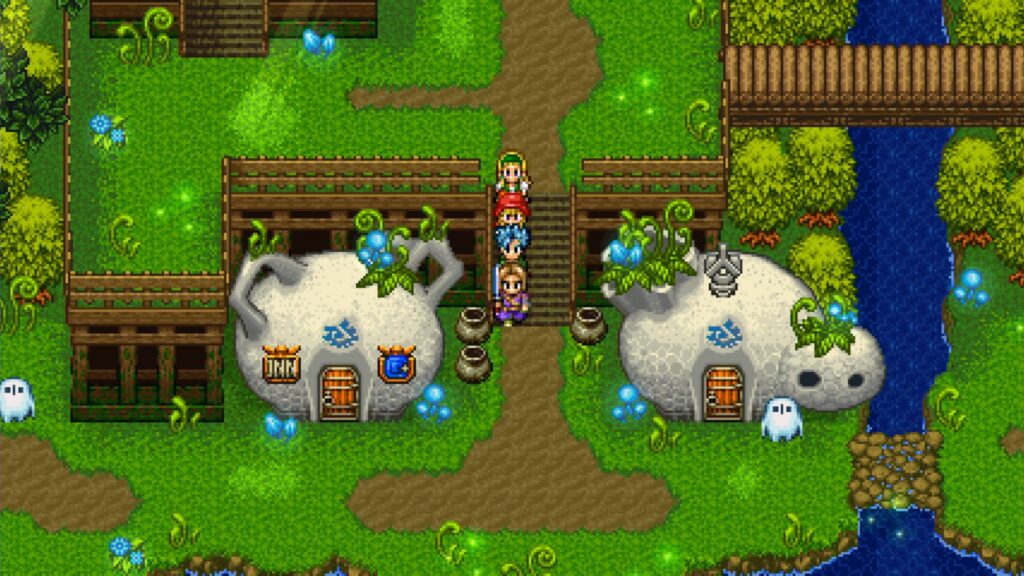
The original Dragon Quest XI and the S version
There are three versions of Dragon Quest XI, which may sound confusing and it really is. This review was based upon the Dragon Quest XI S: Echoes of an Elusive Age and played on a Playstation 4. This version was also released for the Nintendo Switch (earlier), Xbox One, and PC late in 2020, but there was the “original” Dragon Quest XI released in 2017 only for the Playstation 4 and PCs. There are some important differences between these two versions, which I’ll try to cover up here.
Dragon Quest XI S is the better version to play for plenty of reasons. The most important, in my opinion, is the audio quality and options available. In the original version of the game, the sample qualities of background themes were simply horrendous. The game also offers almost no new soundtracks to personalize the experience, what you have here is mostly what you’ve heard in the past ten entries and spin-offs of the franchise. It’s boring to a fault, not only for lacking something new, but because it also becomes repetitive for a game as long as Dragon Quest XI is. It’s baffling how the game came out with this low-quality audio track while there were orchestrated versions of every theme recorded and known. The original version of the game also offers only english voice-acting, which is subpar but does match up with the awesome translation job that incorporates different accents to characters depending on the thematic of the city where they live in.
The improvements in the Dragon Quest XI S start with the proper use of orchestrated samples for the game. It is _much_ better. Although you are still locked with the same ancient soundtrack of previous Dragon Quest games, the quality of these remixes is superb. This version also offers japanese voice-acting, which is of better quality, but at the same time may annoy you because it differs too much from the translation in subtitles and also lacks those quirky accents that give life to many characters in the world.
Another major change is the ability to play the game in 16-bit graphics mode, which sounds amazing but is not exactly up to the task. I mean, the graphics are charming and will certainly please old-school fans, but this mode is not a real translation of the proper game, but based on the _third_ version of Dragon Quest XI released for the Nintendo 3DS. What this means is that combat is once again brought down by the old clumsiness and sluggishness, and that progress is also different in a few aspects, with simplified quests and a rough transition from each mode, requiring additional saves and starting from pre-defined points. It is still an amazing way to play the game for fans of the old entries of the franchise, but certainly not representative of the real thing.
There are many other small tweaks in the Dragon Quest XI S, such as the introduction of a few short chapters in the middle part of the game, new items, bug fixes, the ability to craft items anywhere, and other minor quality-of-life improvements.
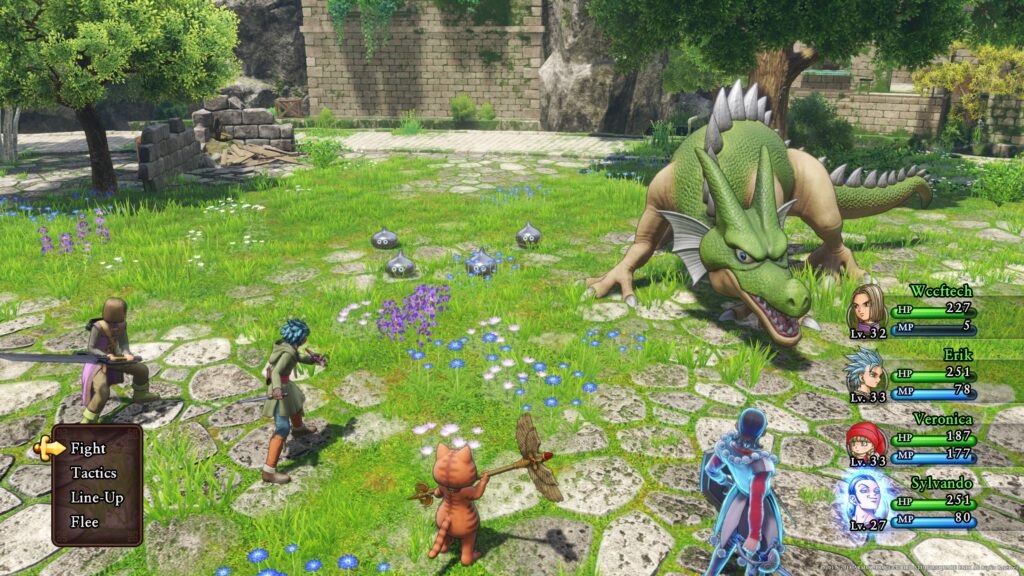
The classic RPG experience
Even though it evolves in many aspects, Dragon Quest XI offers everything a fan of old-school RPGs wishes. The classic turn-based combat is solid, it offers plenty of customization options, flashy skills and spells, and tons of equipment to play around, it has a crafting mini-game to acquire new stuff, horse races, optional challenges, and a lot more. It is a game that is completely packed with content, offering easily one hundred hours of gameplay as you unravel the secrets of the world of Erdrea through the main quest and optional content.
The main quest moves around our protagonist, the Luminary, a hero chosen by the world tree Yggdrasil and destined to save it from evil. After surviving from an attack that destroyed the kingdom of Dundrasil, the Luminary, still a baby, is found by an old man and raised in a distant village as a regular boy. After he comes of age, however, he travels to the kingdom of Heliodor and puts in motion a series of events that unveils the lurking evil powers of the world and sets him on his destined journey.
In general, the main quest is certainly one of the weakest links in Dragon Quest XI. It never really explores the intricate relationships between the kingdoms of Erdrea, and pretty much every background story you find is about the previous Luminary and his quest to save the world from doom, which is essentially a baseline which guides our protagonist in his journey and the very same concept previously used in past games of the series. You will travel through the world, meet your companions, collect artifacts, craft holy weapons, and ultimately fight against the evil overlord. It sounds clichê, and it is. It also drags for too long at many points.
What really makes the world of Dragon Quest XI shine are the side-quests. Not the ones you logged in your menus, but the ones that detail each of the world’s cities, its people, and your companions. There are many tragic tales to be told in here, creating captivating allies and NPCs that will certainly last in the player’s memories.
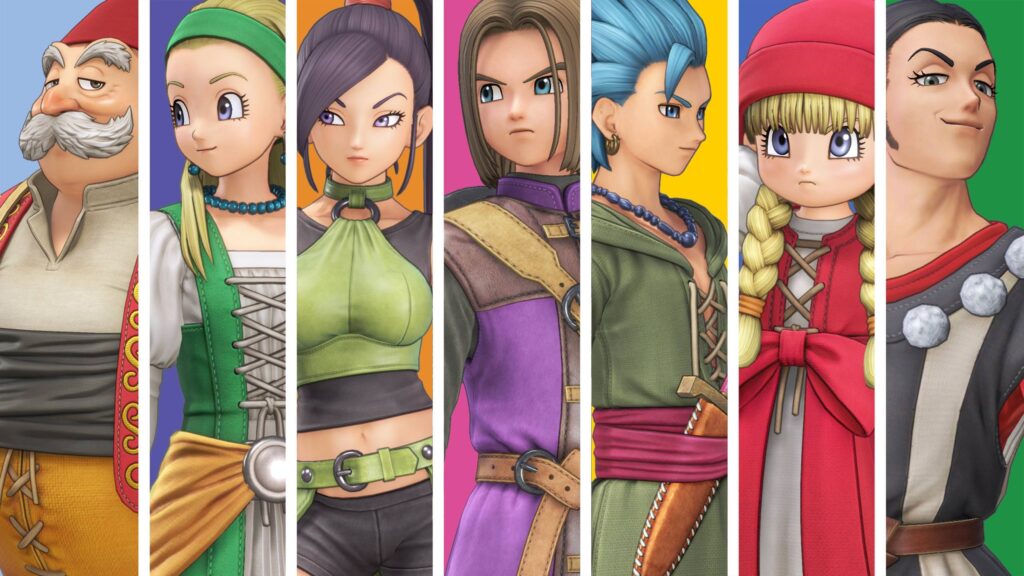
The protagonist and his allies
I’ve said plenty of times before, but the old-school mute characters usually do a disservice to any storytelling. Rarely they add to the journey and most likely they are misused to make scenes weird, wrong, or plainly boring. If there are no personal choices to be made or if the storyline is set in stone, a fully-voiced protagonist with his own mind is not only welcome, but most likely needed to make the tale progress smoothly. Very few games used mute-characters wisely or at least in ways that he is not just a cardboard that makes no sense in existing.
Dragon Quest XI surely misses the mark here. The Luminary is one of the most boring and useless protagonists I’ve seen in a long time. There are no real choices for the player to make here, no branching paths, nothing. He also rarely reacts to anything happening around him, just standing there motionless and with a poker face while the world is being devoured by monsters, while he is being tricked by anyone with a grain for a brain, or even when he knows something that would completely change the events right there. He could easily have a voice to enhance his own saga, or at least make damn gestures and expressions. You see, the Warrior of Light from Final Fantasy XIV is a mute guy/girl too, but he smiles, dances around, gestures, and makes a presence during dialogues and cutscenes. The Luminary does nothing. He is just a cardboard that carries a sword, that only he can wield, to save the world.
Fortunately, for us, the allies you meet are outstanding characters. Some of them, like Erik, undergo profound personality changes throughout the game as you learn more about his past and his problems. Others, like Jade and Rab, are deeply tied to important background tales of the main quest, as well as being the key characters to make the protagonist fulfill his purpose. Sylvando sadly acts like a comic relief on a regular basis, but he has one of the most interesting stories to uncover from the troupe. Serena and Veronica fill the shoes of traditional “deres” from modern animes, but have more important roles in the tale and also grow a lot through the events of the game. Finally, there is an additional character that comes around late in game, who also boasts an interesting tale and growth.
The main allies are not the only ones to grow as you make your way through the journey. There are side-stories in some cities which are simply superb, adding a welcome degree of tension and tragedy to the game. After viewing these side-stories, the world grows on you, the stakes are made clearer, and the reason for saving everything from doom becomes tangible. It’s just sad that the main quest itself is so chained by the franchise’s reluctance in evolving, regardless of the change of times.
Note: There are some spoilers ahead. I cannot, however, feel as if my review is complete without mentioning them. I you don’t want to read it, jump to “It still has a long way to go”
However…
When Dragon Quest XI released back in 2017, there was a trend in the anime industry about regret and heroes being capable of resetting time and redoing past mistakes. It happens that this trend is also seen here. After plenty of hours witnessing some intriguing tales, the game offers our boring hero a trip through time. Here, the game basically undoes any greatness it achieved with its storytelling.
Remember that lengthy side-story about a grieving mother and her sacrifice during her struggle to choose between her son and her people? Well, in this alternate timeline it all goes down to delivering her a random item and everything is solved with no sacrifice, tragedy, deaths, or any sort of problem at all.
This passage above is just an example. The game goes over basically every side-story you have witnessed to “correct” it, throwing away all the bad things that happened and creating “happily ever after” finales to each of them. The game does it by also rushing events in a way it feels boring or completely random. What once took hours to be solved, had plenty of drama, some deaths, cutscenes, and much more, becomes a quest solved by a few lines and some random item delivery that magically makes everything fine. This oozes to the main quest too, with every major plot point being erased and replaced by a few lines of dialogue or, at worst, making some people have a “weird feeling that they’ve seen this before”.
It’s simply terrible. All the work around those tales was outstanding, but then the game nullifies everything for very typical and uninspired outcomes. The worst of it all is that people somewhat retain this “distant memory” of the previous timeline and still glorifies our hero even though he’s done almost nothing in this new timeline to deserve that amount of praise. Much like what happens in animes like Re:Zero, the characters of the new timeline seem scripted to glorify the protagonist regardless of his deeds, and that stains the story of the game by its end in a way I cannot condone.
What about that troupe of carnival dancers that Sylvando gathered in the previous timeline? Well, let’s reuse them by creating a “dance” demon that terrorizes a town and whose problems are solved by a single battle. Damn. Things like these are seen _everywhere_ in this last part of the game.
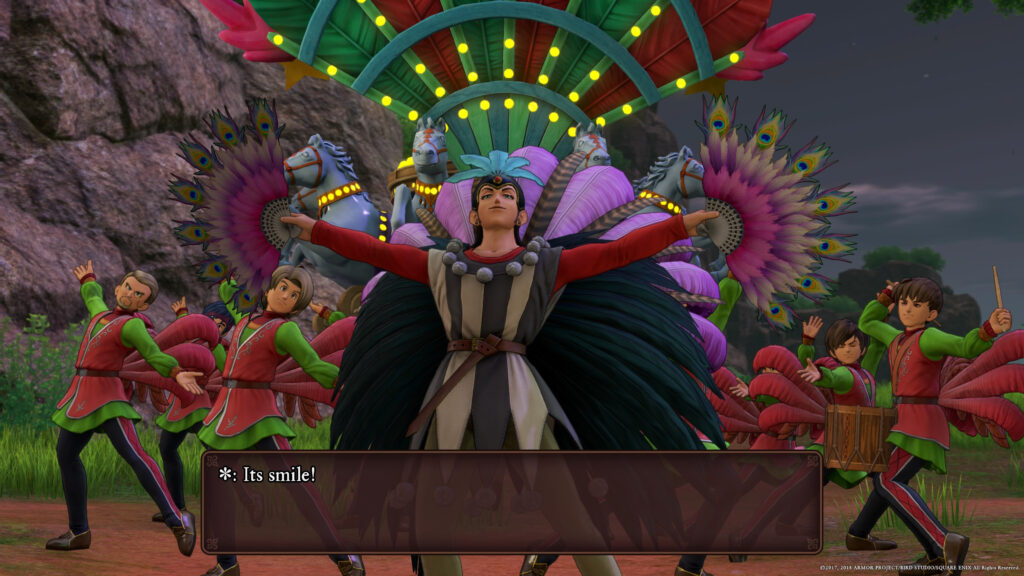
It still has a long way to go
Dragon Quest XI may have finally made a transition to the modern days of video games, but there’s still a lot of work to be done. It can be said that this game achieves, for the franchise, what Final Fantasy VII did more than twenty years ago for Final Fantasy. It’s more than late, it’s unacceptable. However, the end result is an incredible experience of traditional RPG elements that, once again, are hampered by an uninspiring hero, a clichê plot, and an obtuse use of time traveling and resetting storylines by its end.
There are plenty of quality-of-life improvements here, such as healing our party with the press of a button, a faster-paced combat that ditches that annoying phase of selecting actions, a full presentation of combat with movable camera and visible characters, quick loading screens, a reduced amount of text information, diverse fast travel methods, auto-saving features, crafting items anywhere, skippable cutscenes, speech bubbles, and so on. It’s still far from hitting the spot though, as the menu is still an abomination, transfering items is pathetic, there are plenty of key skills depending on random numbers, icons are not intuitive, there’s a lack of an encyclopedia of sorts (which seems necessary for a game with this much content), there’s no reference for turn order (something Final Fantasy X already did nearly twenty years ago), and a lot more. It still feels as if you are playing an old game because of that, and although this can be good to some old-school fans, it certainly needs changes for the game to achieve higher marks in this day and age.
Anyway, despite plenty of minor flaws, Dragon Quest XI S is a must-play for RPG fans. It offers an experience akin to the old days of the SNES while also giving players much needed improvements in playability. It’s trapped by its own terms however, stuck with the mission of being this trip to the past and being limited to truly shining because of it. It does offer a promising future for the franchise though, especially when we consider Square Enix’s money and the sales number the game has achieved abroad. If further quality-of-life improvements are presented, the next game has incredible potential. It will still haunt me with Akira Toriyama’s character design (yes, I abhor his style and the infinite cloned characters in his works), but I’m okay in enduring it if the game has content and quality such as in here.
Detailed Scores
-
Production
-
Content
-
Polish
-
Concept
-
Fun
